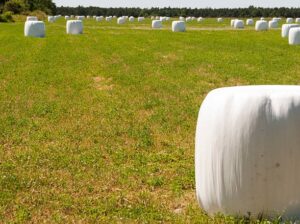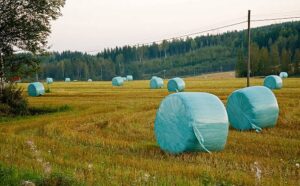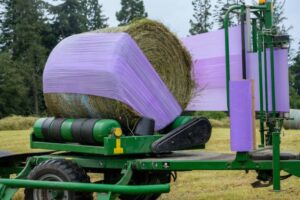Farming
Bale Wrap: Choosing Bale Wrap for Durability and Practicality
The net wrap helps protect bales from the elements to minimise spoilage and loss of forage quality. Did you know that durable bale wrap reduces handling and storage costs and improves feed safety?
Strength
Bales wrapped in plastic film can be stacked to save space, which can help farmers minimise storage and handling costs. This plastic film also protects the bale from the elements, allowing for a longer storage period without spoilage or degradation. In addition, the wrap helps preserve nutritional value and prevents odours from permeating the bales. Plastic wrap is easy to apply and can be purchased from various suppliers. This material is also environmentally friendly, making it a popular choice among farmers.
 Another benefit of using net wrap is that it prevents moisture from forming inside the bales. It is a significant concern for producers who bale wet hay. Moisture in a bale can cause mould growth and reduce the forage quality. Additionally, this moisture can create a layer of decomposed hay on the outside of the bale. It can affect the flavour and quality of the hay and decrease livestock intake.
Another benefit of using net wrap is that it prevents moisture from forming inside the bales. It is a significant concern for producers who bale wet hay. Moisture in a bale can cause mould growth and reduce the forage quality. Additionally, this moisture can create a layer of decomposed hay on the outside of the bale. It can affect the flavour and quality of the hay and decrease livestock intake.A net wrap is a specialised plastic film that can keep bales of wet or dry hay from moulding and improve their nutritional value. It is typically made of high-density polyethylene particles, with UV stabilisers added to improve outdoor stability. This type of wrap is designed to be durable and withstand weather conditions, and it can be applied quickly by a round baler.
Durability
When appropriately used, durable bale wrap minimises bale loss and waste, improving the overall value of your hay. It protects the bale from moisture and other elements that can cause spoilage while reducing physical losses during transportation and storage. It is important to use the right number of layers and proper wrapping techniques to ensure success. A table in the operator’s manual can help determine the appropriate layer count for your bale size and moisture level.
Using net wrap also helps you save time and money. It allows you to create more round bales in the same time as a conventional baler. Moreover, it is available in several different sizes to meet your needs. It is recommended that you use a larger size for higher-moisture bales.
Ease of handling
While it can be time-consuming to wrap large round bales individually, ensuring that the wrap remains intact is worth the effort. It helps the hay retain its nutritional value and allows dairy farmers and beef producers to sort bales based on quality, improving cattle or horses’ feeding efficiency. The wrap also reduces field losses and saves farmers the expense of building a silo or bunk-type storage facility.
When wrapping hay, the most important thing is to keep air out. A bale will leak and spoil if it is not wrapped tightly enough. The number of wraps required depends on moisture levels and the type of hay being baled. The drier the hay, the more layers of plastic wrap are needed to prevent air penetration. In addition, drier hay has sharp stems that may poke through thin plastic wrap layers.
A good rule of thumb is using two puncture-resistant film layers per bale. It is sufficient to protect hay from spoilage and will keep the feed in good condition for a long time. However, some farmers prefer to use more layers, up to six.
After a bale is wrapped, it should be stored away from trees and other objects that can cause rodent damage. Periodically check the wrap and make repairs as necessary. Don’t move or handle the wrapped bales after 12 hours; doing so can expose them to oxygen and restart aerobic deterioration.
Ease of storage
A good way to prevent moisture from spoiling hay is by wrapping it. The plastic wrap keeps the hay dry, reducing the amount of water loss that can cause rotting and mould growth. It can also help protect the hay from damage during transport and storage.
In addition, it can reduce the time it takes to bale hay by allowing the farmer to make more bales per hour. Compared to twine, net wrap only requires a few turns of the baler, and it can save up to 30% in labour costs. It is important because it can lead to significant financial savings for the farm.
The type of durable bale wrap farmers choose depends on the per cent moisture at the time of baling. The drier the hay, the more layers of plastic wrap are needed. It is because drier hay has sharper stems that can poke through the wrap if there aren’t enough layers. Stacking wrapped bales on washed gravel helps prevent leaks by creating a path for rainwater. It also helps to keep rodents away from the bales.
Silage Wrap: Silage Wrap Wholesaler
Silage wrap wholesaler helps farm owners make nutrient-dense, long-lasting feed. It prevents heat and moisture from spoiling the silage, making it more profitable.
There are two kinds of silage wrapping: tube and bale. Tube wrapping has better preservation results because it creates a more sealed environment.
Venuspower 5-layer LLDPE silage film is co-extruded and offers instant tack for an airtight seal with minimal tails. It is UV-stabilised and suitable for Australian conditions.
High strength and puncture resistance
 Silage wrap is solid and durable, making it ideal for wrapping hay or straw bales. It also protects the bales from moulding and absorbs shock during transportation, making it a cost-effective alternative to other materials. It is available in various colours, which can help match the surrounding environment or ensure high visibility.
Silage wrap is solid and durable, making it ideal for wrapping hay or straw bales. It also protects the bales from moulding and absorbs shock during transportation, making it a cost-effective alternative to other materials. It is available in various colours, which can help match the surrounding environment or ensure high visibility.This premium film keeps bales of forage airtight and facilitates controlled anaerobic fermentation, which helps to raise nutrition levels in the grass for livestock and increase the tastefulness of feed. It can also reduce waste and stabilize supply and is suitable for storage in various weather conditions.
The film has a high strength, puncture resistance, and a solid anti-UV function. This prevents the deterioration of the hay during storage and transport and allows for easy handling by the balers.
Strong anti-UV function
Silage wrap, also known as bale wrap or silage film, is a stretch film that preserves forage, such as hay and straw, for livestock feed. It acts as an airtight barrier to protect the forage from oxygen and moisture, preventing spoilage and loss due to weather and pests.
It has a solid anti-UV function to guard against sunlight damage. This helps to maintain the film’s clinging strength and opacity while maintaining puncture and abrasion resistance. For more silage wrap wholesaler, click here.
The colour of the wrap can also influence its ability to resist heat, with white or green wraps being preferable for cooler climates. It has a low light transmission to prevent heat buildup and reduce the risk of mildew. These features help to maintain a healthy fermentation climate for the forage.
High opacity
Silage wrap is a plastic film that helps preserve the freshness of animal feed and reduce spoilage. It also prevents the oxidation of forage, helping to improve its nutritional value. It is beneficial in countries that have a limited harvest season.
The silage wrap wholesalers offer different types of film for bale wrapping, including six-layer co-ex films and high-opacity blown film. These films are ideal for all wrapping conditions and help to prevent over-fermentation. They also protect against rain and other precipitation.
These silage wraps are also easy to install and provide excellent protection for bales. Moreover, they are less prone to damage than net wrap. In addition, they can be used for more extended periods than other types of wraps.
High slip
Wrapped silage is more effective in sealing air and moisture than bagging. It is also easier to manage and less dependent on acceptable weather conditions. The system can also be adapted to different farm conditions.
The 1 mm thick stretch plastic film wraps both wet and dry hay or silage bales to keep out oxygen and limit spoilage organisms. It can be used individually or in line on any wrapping machine. It is available in 20″ and 30″ wide white.
Using silage wraps allows farmers to increase yields and reduce feed costs. It also helps them to store bales for more extended periods. This will enable them to sell surplus feed or use it for other purposes. It is an ideal choice for any livestock farmer. For more silage wrap wholesaler, click here.
Easy to install
Silage wrap is a critical tool in modern livestock farming, preserving the nutritional quality of forage and making storage and transportation more efficient. Its importance is highlighted by the fact that poor-quality wrap can lead to spoilage, financial losses, and health risks for livestock.
To ensure that the bales are wrapped correctly, it is essential to use good-quality plastic. It must withstand punctures, tears, and UV damage while providing optimal airtightness.
A good quality plastic hay wrap will be easy to install and offer excellent reliability during wrapping. It will also have sufficient tack and elasticity to ensure an airtight seal. This will help you get the best forage for your animals while reducing labour and time.
Silage Plastic: Preserving Your Forage With Silage Plastic
Silage plastic can make all the difference between successfully preserving and feeding your forage, or having it completely spoil. A quality product requires little maintenance, blocking out oxygen, air and moisture penetration into your forage.
NetWrap silage plastic that meets all these criteria also comes with an added advantage – complete recycling capabilities. This feature is particularly important in today’s global environment of labour and raw material shortages.
Moisture Control
 Silage plastic is made of multi-layered film designed specifically to be bale wrapped. Its multi-layer technology ensures it keeps strong adhesion, seals well during storage and feeding and protects feed against environmental damage while simultaneously increasing nutritional value and improving animal performance. Silage wrap can be used on dry or high moisture baling and protects feed against environmental damage – ideal for dry baling as well as high moisture baling applications.
Silage plastic is made of multi-layered film designed specifically to be bale wrapped. Its multi-layer technology ensures it keeps strong adhesion, seals well during storage and feeding and protects feed against environmental damage while simultaneously increasing nutritional value and improving animal performance. Silage wrap can be used on dry or high moisture baling and protects feed against environmental damage – ideal for dry baling as well as high moisture baling applications.Silage wrap can protect bales from air exposure and, as a result, reduce spoilage and improve forage quality by keeping oxygen out and protecting its nutritional content and decreasing time needed to reach anaerobic conditions. Furthermore, it reduces mycotoxins produced during mold growth.
Silage wrap can help limit mycotoxins produced during fermentation by keeping oxygen out and restricting mold growth, thus helping minimise their production and exposure to animals. Silage wrap also keeps oxygen away, further diminishing mold’s ability to flourish, thus decreasing mycotoxins production and their associated health concerns.
To maintain proper air control, it’s essential that silage be covered at an optimal time. Covering round bales immediately after filling will reduce separation and help achieve a denser pack, while in concrete silos covering with tires weighted down will keep air out while also limiting spoilage.
UV Protection
When selecting NetWrap silage plastic to preserve your crop, UV resistance is of vital importance. This will protect against degradation during storage and feeding as well as reduce wasteful forage losses that would otherwise take up too much of both your time and money.
Select a blown stretch film with UV resistance and puncture and tear resistance; this will make wrapping bales much simpler and faster while protecting its integrity during application and handling processes.
Raw materials used in silage wraps and covers can impact their cost and performance. Lower quality raw materials could result in the film not stretching properly or losing its integrity after stretching – leading to airflow permeating into your silage and premature spoilage of it.
Puncture Resistance
Silage film helps protect crops meant for feeding livestock, protecting hay and straw bales from moisture, dirt, insects and other elements that could compromise its nutritional value and spoil its food source.
Permeability (OTR) is one of the key criteria in selecting an ideal silage wrap. A lower OTR value will increase its value; you’ll then make back your investment when harvesting and feeding livestock.
Puncture resistance is another essential quality of NetWrap silage plastic and offers farmers who value protecting their investments with silage plastic an excellent choice. High puncture resistance offers increased resilience against impact or other mechanical forces that could tear or rupture it, providing peace of mind that their investments remain safe.
Strength is another crucial aspect of silage wrap, which can be measured using its tensile strength or elongation index. As these values increase, so will its strength. Film with high tear resistance ensures stable use during use which prevents air, moisture, and oxygen from spoiling crops and is particularly helpful to farmers who wish to preserve harvests for as long as possible.
Recyclability
Plastic silage wraps are far more durable and efficient to use than their paper or tarp counterparts and make for faster bale wrapping or stacking operations. No breaks occur easily when wrapping bales or stacking them compared with traditional hay/straw covers which often rip or tear under windy conditions or on silos without walls.
Be mindful that not all plastics are equal when selecting your silage cover material; quality will directly influence its lifespan and durability. PVC may be suitable for cheap tarps due to its chemical resistance, however due to low UV protection PVC isn’t appropriate as a silage cover material; look instead for products made of polyethylene (PE) with higher concentration of stronger RPE layers for long-term durability and chemical resistance.
These films boast increased reinforcement, enabling them to stretch over larger areas of a bale and provide superior performance and longevity compared to unreinforced PE covers. When selecting NetWrap silage plastic for your farm, opt for reinforced materials with 5 or 7 layers constructed. This will guarantee stronger and more durable films capable of withstanding the challenges presented by busy dairy farms. Dairy Australia has already implemented a successful silage plastic recycling trial in Western Victoria and is working closely with private industry to expand this service throughout Victoria.